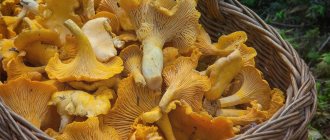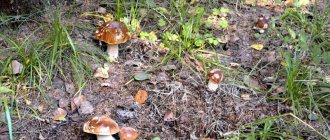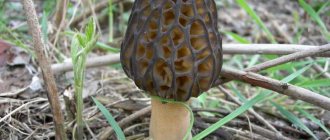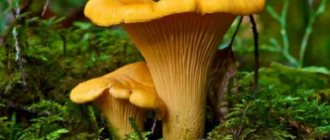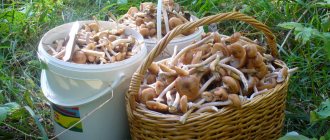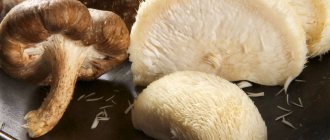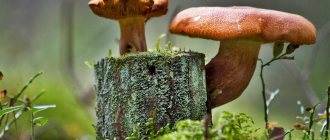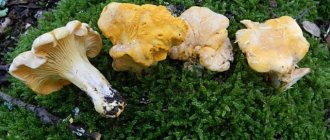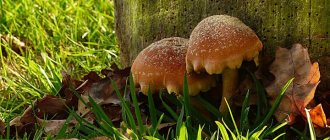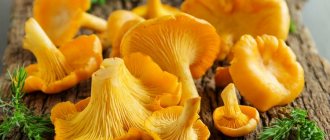More than 3,000 species of mushrooms grow in Russia. It is clear that they do not all bear fruit at the same time. The mushroom season lasts from early spring until December, when the first frosts occur. Each variety requires its own comfortable conditions for growth: a certain temperature, amount of light, moisture, nutrients, etc. In addition, each type of mushroom is found in strictly defined forests: some only in deciduous forests, others - in mixed ones, others - in conifers. Our material today is about when and what mushrooms can be collected in the forest, what to look for when choosing a place and time to collect, what you need to have with you, as well as some safety measures during a “silent hunt.”
Mushroom picker lunar calendar 2022
Mushroom bodies are 70-90% water. It is not surprising that the changing phases of the moon affect their growth. Experts say that growth is significantly activated during the waxing Moon and slows down during the waning Moon. And any experienced mushroom picker and harvester will confirm that fruit bodies preserved for the waning moon turn out much tastier, and most importantly, are better preserved.
Below is a schedule of favorable periods for collecting and preserving mushrooms. However, do not forget that regardless of the phase of the moon, the main factor in increasing the yield in the forest is good rains.
For mushroom picking in 2022, the phases of the waxing moon that fall on:
- April 23-30;
- May 1-6, 23-31;
- June 1-4, 22-30;
- July 1-4, 20-31;
- August 1, 2, 19-31;
- September 1, 18-30;
- October 1, 17-31;
- November 16-29.
For winter preparations (pickling, canning, freezing and drying), the phases of the waning moon in 2022 will be ideal:
- from 4 to 18 August;
- from September 3 to 16;
- from October 2 to October 15;
- from 1 to 13 November.
Where do different types of mushrooms grow?
To collect full baskets of mushrooms, you first need to decide which variety will become the most popular. For example, to find champignons and bluelegs, it is better to take a closer look at the Leningrad, Belorussian, Kursk and Yaroslavl directions. Lovers of boletuses (boletus and boletus) should take a closer look at the Riga and Paveletskaya branches. Gourmets who prefer boletus mushrooms should go in the Yaroslavl direction.
After looking at the mushroom map, you should pay close attention to the four most popular places:
- The western direction annually pleases mushroom pickers with a treasure trove of mushrooms, russula and milk mushrooms.
- From the end of summer until the first frost, you can find in the forest belt such edible gifts as: boletus, boletus, poplar and other varieties of rows;
- In coniferous plantings you can find all edible species that grow near pine and spruce trees from mid-September until late autumn;
- In search of porcini and Polish mushrooms, you should go to mixed plantings;
- In birch and aspen trees during the off-season you can find husks. Boletuses and boletuses are most often found as a result of rains, when the weather remains warm outside.
Mushroom growth calendar by month
You can harvest mushrooms almost all year round. Of course, in the coldest winter months it is possible to find only oyster mushrooms or truffles (and only if the frosts are not particularly severe), but starting in April, the mushroom diversity grows day by day. Peak season – July-September. Each variety appears at its own time:
- in January-March there are practically no mushrooms, you can find a few oyster mushrooms, and truffles in the southern regions;
- morels appear in April;
- in May - boletus, boletus, russula;
- in June, the collection of boletus, boletus, aspen, boletus, chanterelles, champignons, and russula begins;
- in July-September the same species are collected as in June, but milk mushrooms and honey mushrooms are added to them, by the end of July - saffron milk caps, by the end of September - honey mushrooms.
- October is rich in porcini mushrooms, boletus, boletus, champignons, russula, honey mushrooms, milk mushrooms;
- in November you can only find honey mushrooms, oyster mushrooms, and truffles;
- in December - oyster mushrooms, truffles.
Boletus and boletus
Boletus Photo: Maxim SHANIN, commons.wikimedia.org
The third main mushroom is, of course, boletus. In the south of the Moscow region, towards Kaluga and Ryazan, boletus began to grow along light birch edges literally a few days after the boletus. And every warm day it becomes more and more. And most importantly, these mushrooms are almost worm-free.
Following the boletus, the first aspen boletuses have already begun to appear, which you need to look for along the edges of young aspen and birch trees. In my opinion, only a young boletus in beauty and stature, popularly called “chelysh”, still with an unopened cap, can compete with the boletus.
How to identify a mushroom forest?
Mushrooms are very demanding on environmental conditions. They do not like excess moisture, so they cannot be found in wetlands, in thickets with dense vegetation, where it is always damp and sunlight does not penetrate, in dense thickets of grass, bushes, and heather. Likewise, they do not like too dry areas of the forest.
The most prolific are pine forests, birch and oak groves with sparse undergrowth, and semi-shaded forest glades, especially at higher elevations. Mushroom places can be found in sparse forests on the northern side of the trees, in abandoned corners along old meadows and remote paths.
Mushrooms pickyly choose their neighborhood. For example, porcini mushrooms grow only in woody forests that are at least 50 years old next to oak, hornbeam, aspen, and pine. In hot weather they can be found under the ferns in wetter lowlands. The white mushroom itself is chosen as a neighbor, for example, fly agarics. It is not for nothing that a folk superstition says that fly agarics point the way to boletus mushrooms.
Mushrooms of the autumn forest
In autumn, almost all types of summer mushrooms grow, but new ones also appear, those for which it is too hot in summer. These are, for example, autumn honey fungus, greenfinch, row and others. Moreover, in autumn the growth of mushrooms is most intense, since they do not like heat, and in order for the fruiting body of most species to begin to develop, 5–10 ° C is enough. The temperature at which mushrooms grow in the fall affects the speed of their development: the lower the degree, the slower they grow.
However, not only temperature indicators matter, but also humidity. If autumn is dry, then you can’t count on a good “catch” of mushrooms. However, they don’t like prolonged rains either. An experienced mushroom picker will look at how the next bad weather splashes on the roads in puddles, and sigh sadly: “Eh, the mycelium will get wet!” The mycelium, of course, will not get wet, it will remain under the dense forest floor of fallen pine needles and moss, but there may indeed be no mushrooms.
But light frosts, which are not uncommon in autumn, are not scary for mushrooms. Sometimes on a cold October morning in the forest you can find boletus, boletus, redhead, boletus, and honey mushrooms literally frozen through. When determining at what temperature mushrooms grow in the forest in the fall, you should focus on average daily values, since warming up the soil during the day plays an important role.
Where can I find the right variety?
Knowledge of which plants mushrooms prefer as neighbors will help you find the desired types of forest gifts.
So, you will find boletus in birch groves or mixed forests with the presence of birch. The boletus usually hides in the grass or under leaves. At the same time, remember that if you find one specimen, there are more nearby, because boletus mushrooms grow in families.
We have already talked about where and how oyster mushrooms are collected here.
Boletus, as the name implies, is found in forests dominated by aspen and also grows in groups. It is easy to find boletus by its bright red cap.
Saffron milk caps are hiding in the pine litter. However, they are easy to spot by their bright orange color. In addition, saffron milk caps grow in very large groups. It’s enough to find one place – and you already have a full basket!
The fox chooses a neighborhood with oak, beech, birch, and pine. She likes more moist, mossy places in shady lowlands, at the foot of low hills. Chanterelles grow in large clusters.
Honey mushrooms are found everywhere in deciduous and mixed forests, in the meadows of the forest-steppe zone. They are usually densely dotted with old stumps or trunks of fallen trees.
Maslyata is the most widespread and prolific variety in domestic coniferous forests. They begin to actively grow after warm summer rains and can form an entire plantation densely dotted with fruiting bodies.
Milk mushrooms are ideal for pickling and pickling. In addition, they do not need soaking, which significantly speeds up the preparatory work. However, they are difficult to find. This variety of mushrooms prefers forest areas with a predominance of bird cherry, birch and shrub vegetation. Milk mushrooms can be found near paths and along river banks. The difficulty of searching lies in the fact that each specimen is hidden in dense foliage, buried so that just a mound is visible from above. To get to the mushroom, you need to dig up the foliage. But an inexperienced mushroom picker doesn’t even notice such places.
Champignons are unpretentious mushrooms, but they still prefer nutritious soil rich in humus or mixed with manure. Colonies can be found in meadows, pastures, forests and near people - in a vegetable garden, in a park.
When the frost hits
Few of these forest dwellers can survive severe frost, and most mushroom pickers believe that the season ends in November. But that's not true.
One of the most cold-resistant mushrooms is honey mushrooms. The best temperature for their growth varies in the range of +8 ... +12 oC. Their cheerful families grow in the forest even after serious frosts. At what temperature do mushrooms grow in autumn? Winter honey mushrooms, for example, can be found at sub-zero temperatures, even under snow.
Winter oyster mushrooms are also not afraid of frost, which can be harvested not only in November, but also in January.
What is the best time to go mushroom picking?
The peak of the mushroom season occurs in July-August. During this period, up to 50% of the total annual harvest is harvested, in the autumn months - about 30-35%. However, in order for the mycelium to release a fruiting body, special climatic conditions are necessary. So, in a dry summer, when the air temperature is too high and, accordingly, the soil warms up too much, there may be no mushrooms at all. But after the rains, when the soil is well saturated with moisture (to a depth of at least 10 cm), and the air temperature remains at a comfortable level of +15...+25 °C for about 7-10 days, mushrooms begin to actively climb out of the ground. This is the best time to harvest.
Read also: “How to properly search for and find mushrooms in the forest?”
When does mushroom picking start and end?
Not only in the Moscow region and Moscow region, but also in other regions of Russia, as well as neighboring countries - Ukraine and Belarus, fruiting occurs at an approximately specified time, with an error of 7-14 days.
Important!
Sometimes the activation of the mycelium is delayed due to lack of precipitation. Dry weather with sweltering sun cannot allow mushroom pickers to reap a good harvest. Fixing a common problem is possible by following known calendars, weather conditions and recommendations left on a local forum or social networking group where real users leave fresh reviews.
Useful tips
Picking mushrooms only at first glance looks like an ordinary walk in the forest. In fact, this event requires special knowledge, skills and preparatory measures. And it’s not just a matter of distinguishing mushrooms by appearance and being able to identify places. Collection containers, the choice of clothing, and orienteering skills in the forest are also important.
Let's start with clothes. Her choice depends on the season, but there are still several general all-season rules:
- do not wear synthetics, as this may lead to overheating;
- all clothing should be made of dense natural fabrics, preferably cotton - military ammunition is ideal;
- at any time it is better to wear things with long sleeves and trouser legs that fit tightly to the body and protect the neck (this will protect against ticks and insects);
- It is advisable to wear a windbreaker with a hood on top: the head should also be protected from ticks and insects;
- suitable shoes for any season are boots or boots: they are comfortable, stable, injury-proof, and can protect against snake bites.
The ideal container for collecting forest harvests is a wicker basket. It has rigid walls and many holes that provide good ventilation. You can use containers, which you then carefully place in your backpack. This method will allow you to bring home up to 20 kg of mushrooms. Buckets and plastic bags are the worst option. In such a container, most of the fruiting bodies will be wrinkled or broken.
What other recommendations are worth considering?
- Always have a knife, matches, and first aid medications with you. You will need a knife to pick mushrooms, everything else will come in handy in an emergency.
- Never collect mushrooms along highways, even if there are whole glades of them, or near landfills, industrial enterprises, etc. Mushrooms absorb pollutants more strongly than plants and become hazardous to health.
- If you find a mushroom, do not rush to move on. Most species grow in colonies, so there are likely to be others nearby.
- Any doubt that arises regarding the edibility of a found specimen must always be resolved in favor of inedibility. Leave the strange mushroom to continue to grow.
How not to get lost in the forest?
- When going into the forest, warn your family and friends. This will help organize a search earlier if you do get lost.
- Do not go far from home and do not go deep into the thicket, even if you know the forest well.
- Don't leave the path, wanting to take a shortcut home. This is the reason why people get lost most often.
- Go out at dawn, because time passes quickly in nature, and it’s much easier to get lost at dusk.
- Never pull a mushroom out of the ground. This destroys the mycelium and next year there will be no harvest in this place. The fruiting bodies must be carefully cut off at the root with a sharp knife.
- Before heading into the forest, it is advisable to study a map of the area and determine in which direction residential buildings, rivers, clearings, and other landmarks are located.
- The ideal option is to have a GPS navigator with you.
- Don't go into the forest alone. It's always safer to do it together.
- If you often plan to go into the forest, study the rules of navigation. This will help in a difficult situation.
- You can navigate the forest using many signs. The simplest are the smells of smoke or manure, the sounds of a railroad or highway.
- Dress brightly. This will help rescuers find you faster.
- If you do get lost, stop, take a break, light a fire and wait for help.
How to get there by car?
- Drive from Vnukovo to the junction nearby and turn towards Ankudinovo. This is a good place to park your car near any of the nearby villages. Here you can also collect an impressive amount of mushrooms. An alternative option is to drive to Krekshino, turn right, stop near Aprelevka and comb the local forests.
- Along the Minsk highway, focusing on the Zhavoronok station, drive a little north.
- Drive along New Riga, and as soon as you get to Novy, turn towards Novoarkhangelsk, where there is a place for a car next to the river and go in search of “trophies” in the forest park.
- If you drive along Leningradka or Pyatnitsky, you can stop in the Mitino or Khimki area, but it is better to get to Eleno, which is behind Sheremetyevskoye Highway and Black Gryad.
- You can take the Gorkovskoye Highway (alternatively the Nosovikhinskoye Highway), get to Vlasovo or Subbotino, where there are good mushroom glades in the vicinity.
What you need to know about poisonous mushrooms?
The danger of picking mushrooms is quite comparable to the danger that can await you while hunting a predator. The difference is that when hunting, the consequences can occur immediately, but when picking mushrooms a little later. The fact is that almost all edible mushrooms have doubles, and some species have several. Some can be distinguished, while others, for example, as in the case of chanterelles, are almost impossible. There are almost no differences between them and only a person with extensive experience can understand that a false fox is in front of you.
The most dangerous boletus mushroom counterparts are the gall and satanic mushrooms. With a lack of experience, it is easy to confuse the forest champignon with the pale toadstool or the stinking fly agaric. Butterflies are similar to pepper mushrooms, and honey mushrooms are similar to false analogues. False honey mushrooms are the easiest to distinguish: they have a bright color (brick-red or gray-yellow).
To protect yourself, be careful:
- do not put unfamiliar copies into the basket, hoping to ask someone later;
- do not take questionable fruits;
- Go on a “silent hunt” only with very experienced mushroom pickers.
Butter
Butterflies Photo: commons.wikimedia.org
You should look for these cute mushrooms (hence the name) exclusively in young pine trees, up to five meters high. I now find early boletus under trees, but most of them are in the tall grass in the field. The main thing here is not to choke the mushrooms and carefully move the thickets apart. But there must be pine trees nearby.
There are two types of butter - granular and real. Many mushroom pickers do not distinguish them, and this is not necessary - among the butter mushrooms there are no inedible species, and it is impossible to confuse them with some false poisonous double.
But if a grainy oiler is common at the beginning of summer, then a real one, denser and more powerful, appears only in August and September. The distinctive features of these two types are that the granular one does not have a film under the cap.
I think there is no finer mushroom for pickling than buttercup. Some mushroom pickers remove the mucous skin from the cap, some boil it with it: it all depends on the individual reaction of the stomach and how aesthetically pleasing you want the mushroom in the jar to be. Without the skin, of course, it’s more beautiful.
| Recipe for pickled butter For one liter of water: 2 tablespoons of sugar, 4 teaspoons of salt, 3 bay leaves, 6 black peppercorns, 3 cloves, 3 cinnamon sticks. Preparation. Add all ingredients to boiling water, remove from heat and add three teaspoons of vinegar essence. Cool. Pour the marinade over the boletus, previously boiled for five minutes with salt and vinegar. Cover (it is better not to roll up to avoid botulism) with a lid and store in a cool, dark place. |
Folk signs about mushrooms
- There are more mushrooms in foggy weather.
- If midges are swarming, it means there is a mycelium nearby.
- If the rowan blossomed late, then the autumn will be fruitful.
- Rain on Trinity - time to pick mushrooms.
- Down from the aspen - it's time for the boletus.
- When the oats are ripe, honey mushrooms appear in the forest.
- If June turns out to be hot, you won’t see boletus mushrooms.
- Rain in the evening - expect mushrooms in the morning.
Quality of early mushrooms
According to statistics, every third Russian becomes a real mushroom picker during the season, while the majority traditionally start picking mushrooms no earlier than mid-June.
The first white boletuses, boletus and boletus are traditionally called “spikes” - their growth coincides with the beginning of heading in the rye fields.
Early mushrooms, however, are not of good quality and are often worm-eaten: fungus gnats and flies happily lay their larvae in them.
Dmitry Tikhomirov, project “Mushroom Hunter” Photo: Natalia SIDOROVA
conclusions
- Experts recommend checking the phases of the moon when planning the collection and preparation of mushrooms for the winter.
- In order for the forest harvest to be successful, it is necessary to study in advance the distribution features of certain varieties.
- Plan your mushroom hunting trip carefully: choose the right clothes, study the area, warn your relatives. These measures will help avoid serious troubles.
- It is important to know not only when to pick mushrooms in the forest, but also how to do it correctly so as not to harm the mycelium. But most importantly, you need to be extremely careful when choosing specimens so as not to accidentally bring home poisonous mushrooms.
Chanterelle
Chanterelles Photo: commons.wikimedia.org
Chanterelle is the same early mushroom as boletus. In the very south of the region there are already the first finds - this is, of course, chanterelle, which we value not only for its taste, but also for its absence of worms. You need to start looking for these bright yellow mushrooms along the birch edges, but by mid-June the chanterelle, following other mushrooms, will begin to grow in the depths of the forest. And if you come to such a “chanterelle” meadow, then from one mycelium you can easily pick up half a basket. True, there is one subtlety when preparing it: it is better to boil the chanterelle before freezing, otherwise it may taste bitter.
